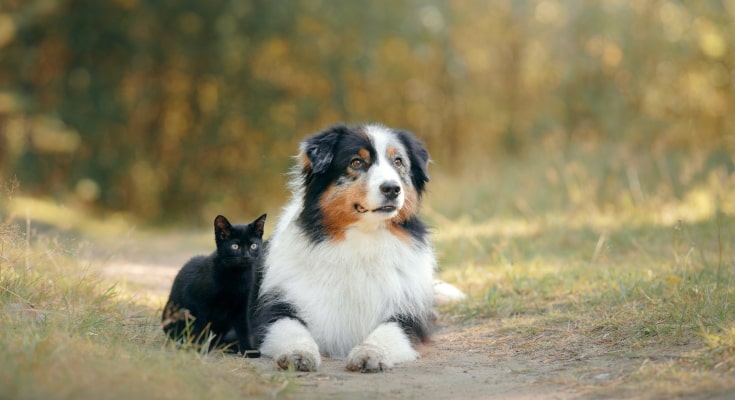Having the right pet insurance can play a vital role in caring for your cat or dog throughout their lifetime. However, the number of different options and prices can seem overwhelming. This guide can help you understand what can affect the cost of your pet insurance.

What is the average cost of pet insurance?
On average, a MORE THAN customer pays £219.54 a year* for their pet insurance. This is the equivalent of £18.30 per month.
Dog insurance is usually more expensive than cat insurance, but that won’t always be the case for every cat and dog.
Different factors influence the cost of an individual pet’s insurance.
What is the average cost of dog insurance?
On average, a MORE THAN customer pays £237.31* for their dog insurance per year, which is the equivalent of £19.78 per month.
How does breed affect dog insurance costs?
The cost of dog insurance can vary by breed, particularly if a dog is a pedigree. This is because different dog breeds are susceptible to certain genetic conditions. For example, cruciate disease in Labradors and osteosarcoma in Dobermans.
Vet fees can also differ between breeds. This is because vets usually have a price structure system that groups by size – small, medium or large. This is because larger dogs will need higher doses of general anaesthetic, for example. The size of a dog is often determined by their breed type.
What is the average cost of cat insurance?
On average, a MORE THAN customer pays £136.65* for their cat insurance per year, which is the equivalent of £11.39 per month.
Cost of cat insurance by breed
Though cat insurance costs can vary by breed, this is usually not as much as it varies for types of dog breed. This is because there aren't usually big differences between breeds of cat, such as size, like there are for dogs.
However, some pedigree cat breeds are more expensive to insure than others. This is due to genetic predispositions to certain conditions and illnesses. For example, Persian cats are susceptible to Polycystic Kidney Disease. Himalayan cats are more likely to experience breathing issues, such as feline asthma.
What impacts the cost of pet insurance?
Different factors can affect the cost of your pet's insurance, such as:
- Age: As your pet gets older, their pet insurance costs increase. This is because older pets are more prone to illness.
- Breed: Differences between breeds can cause the cost of insurance to vary. This is especially the case if your pet is a pedigree.
- Advancing treatments: Improvements in veterinary care can increase costs of treatment.
- Claims: A claim being paid can also cause your renewal price to increase.
- Insurance Premium Tax: The government makes the decision to raise or lower this tax rate. This can cause pet insurance costs to go up or down.
You may also consider:
Your excess
There is a fixed excess charge to pay on all pet insurance claims at MORE THAN, which is the case for most pet insurers. At MORE THAN, the cost of the fixed excess is £100. You can also choose to pay an extra voluntary excess of either 10% or 20%. If you choose to do this, the premium that you pay either every month or every year will be lower.
Whether your pet is spayed or neutered
Spaying or neutering your pet won’t directly reduce your insurance premiums. However, there are benefits to doing so that may include reduced costs over a longer period. Neutering or spaying your pet is good for them as well as you, as it lowers the likelihood of straying. Risk factors for some conditions and diseases, such as certain cancers, are also reduced by neutering or spaying.
Whether your pet is vaccinated
It is important to make sure your pet is vaccinated and that you keep their vaccinations up to date. Vaccinations alone do not lower your insurance premiums. However, they will keep your pet protected against some harmful illnesses. They also lower the risk of needing potentially expensive vet treatments.
Like most pet insurers, MORE THAN does not cover vet treatments for vaccine-preventable illnesses except where the vaccine has failed.
Insurance that suits you
It’s important to make sure that the cover you choose for your pet is right for them and for your lifestyle. Cost is just one of several factors to consider when making your choice.
Important information
*Based on new customers who purchased annual cover. Excludes optional extras & includes any applicable discounts
(MORE THAN data February 2022 - January 2023)
The cost of looking after your pet's health doubles every four to five years. That's why your renewal price increases each year and your excess will increase when your pet turns nine. If a claim is paid, the price you will pay next year can double.
It’s important you budget for renewal prices to increase as your pet gets older. There is no limit to how much your renewal price can increase over time.


